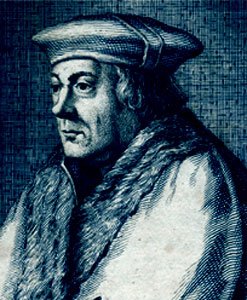
Work on the “Great Bible” began in 1536 when Thomas Cromwell, chief spokesman for King Henry VIII in Parliament, asked his friend Miles Coverdale (of Coverdale Bible fame), and publisher Richard Grafton, to create a new revision based on the Matthew’s Bible. Coverdale accepted — as if he really had much choice. Cromwell was the second most powerful man in England (next to the King himself). In 1533 Cromwell had become Secretary to the King, in 1534 he became Principal Secretary and Master of the Rolls, and in 1536 Cromwell was named Keeper of the Privy Seal — not the kind of man you want to make mad. Saying “no” to Cromwell would be as good as saying “no” to King Henry himself — not a way to keep one’s head! Cromwell always remained involved in the production of the Great Bible. So while Coverdale worked on the actual revision, Cromwell decided that this Bible would be “the most sumptuous book ever printed up to that time”.

The Great Bible certainly fulfilled Cromwell’s requirement
that it be the world’s most beautiful and impressive book. The size of its pages was immense — 11 inches wide by 16½ inches long and it quickly became known as the “Great Bible” because of this. And although it was possible to buy an unbound copy (i.e., just the pages), most Great Bibles were sold with rich, lush, expensive bindings.
The Great Bible was impressive right from the start. It had a finely-engraved Title Page in which Christ is pictured blessing Henry VIII, who is handing out copies of the new Bible to Cromwell (representing the State) and Thomas Cranmer, Archbishop of Canterbury (representing the Church). Although this Title Page said that the revision was done by “diverse, excellent, learned men”, the Great Bible was basically a revision done by just Coverdale himself, consulting the works of others, as needed.
The first edition of the Great Bible is sometimes known as “Cromwell’s Bible”, because Thomas Cromwell was the driving force behind the project. A special, personalized copy on vellum was printed especially for him. The copy was enhanced by beautiful colored pictures and skillful calligraphy. If you’re ever at Cambridge in England, you can admire Cromwell’s special copy, which on display at St. John’s College.
But alas, this time of general Bible reading was short-lived. King Henry was a fickle man, and soon his attitude about this new translation began to change. After 7 printings in just 2 years, the presses were shut down, per orders from the King. And in 1543, with the Great Bible just 4 years old, it was enacted by Parliament that “no manner of persons, after the first of October, should take upon them to read openly to others in any church or open assembly within any of the King’s Dominions, the Bible or any part of the Scripture in English, unless he is so appointed thereunto by the King … on pain of suffering one hundred month’s imprisonment.” And women not of noble birth were forbidden to read the English Bible at any time, even in private.
